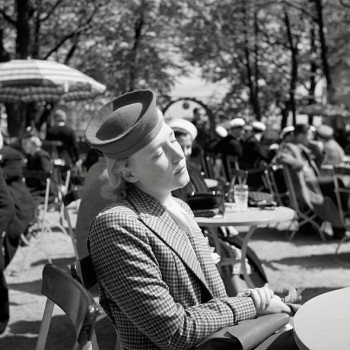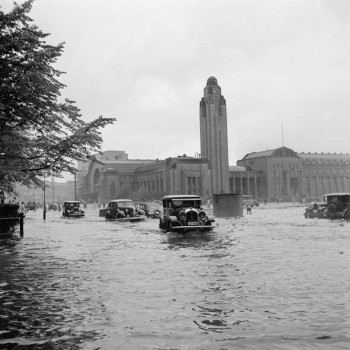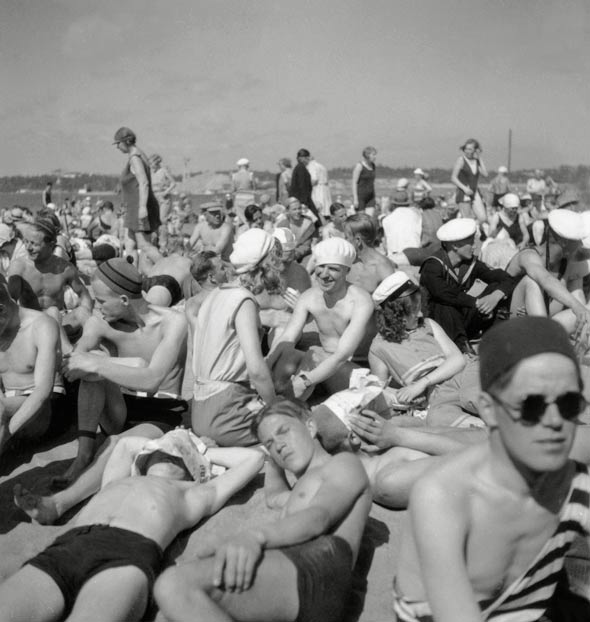Sun and shade
3 August 2011 | Extracts, Non-fiction

Springtime: the new graduates celebrate the beginning of summer. Photos: ©Jussi Brofeldt
Documentary film-making and photography arrived in Finland in the 1920s with pioneers like Heikki Aho and Björn Soldan, who founded a film company in 1925 in Helsinki. They also took thousands of photographs of their city; in a selection taken in the turbulent 1930s, people go on about their lives, rain or shine
Photographs from Aho & Soldan: Kaupunkilaiselämää – Stadsliv – City life. Näkymiä 1930-luvun Helsinkiin (‘Views of Helsinki of the 1930s’, WSOY, 2011)
Photos: Aho & Soldan@Jussi Brofeldt. Texts, by Jörn Donner and Ilkka Kippola, are published in Finnish, Swedish and English.
The exhibition ‘City life‘ is open at Virka Gallery of the Helsinki City Hall from 1 June to 4 September.
Aho and Soldan were half-brothers, Heikki the eldest son of the writer Juhani Aho (1861–1921; an extract from one of his novels is available here) and the artist Venny Soldan-Brofeldt. (Juhani Aho changed his original Swedish surname, Brofeldt, to Aho in 1907), Björn Soldan was Aho’s son from an extramarital relationship.

A moment in the sun: Esplanade Park in the heart of the city
As Ilkka Kippola writes in a catalogue article entitled ‘Documentary and photographic modernists’ in the book that accompanies the show‚ Soldan was Finland’s first professionally trained cameraman while Aho was an expert in post-production work.
Together, they produced hundreds of documentaries as well as thousands of photographs from the 1920s until the mid 1940s. Aho’s daughter, the photographer and documentarist Claire Aho (born 1925) continued the work of her father and the company until the 1960s.
In an article entitled ‘Helsinki in the 1930s’, the author and filmmaker Jörn Donner takes a look at the history and politics of the decade.
In the autumn of 1930 political unrest began to manifest itself in the abduction of the country’s former president K.J. Ståhlberg: right-wing forces planned to transport him across the border to Soviet Union.

The shape of things to come: this photo is from 1941; the men are saluting the closing of the Soviet Embassy in Helsinki in advance of the Continuation War against the Soviet Union, which began later that year
A large number of farmers had marched in Helsinki earlier that year to demonstrate, demanding more authoritarian order in place of parliamentary democracy.
The abduction proved a failure, and the Ståhlbergs were allowed to return to home. However, parliamentary democracy was not yet safe in a country that had only gained independence as recently as 1917, followed by a bloody Civil War in 1918.
In 1932 an armed right-wing extremist rebellion also failed.

Summer flood? The Railway Square taken by surprise
Later a broader coalition of political parties was able to develop democracy – which proved vital later, as Donner points out, when, in 1939, the Winter War broke out.
The war caused the cancellation of the 1940 Olympics, which eventually took place in Helsinki 12 years later.
Summer 2011 in Helsinki has been the warmest in several decades – the photos here give a few glimpses of sunny days in the city eight decades ago.

Sun is fun: a Helsinki beach in the 1930s. Photos: ©Jussi Brofeldt
Tags: Finnish history, Helsinki, photography
No comments for this entry yet
